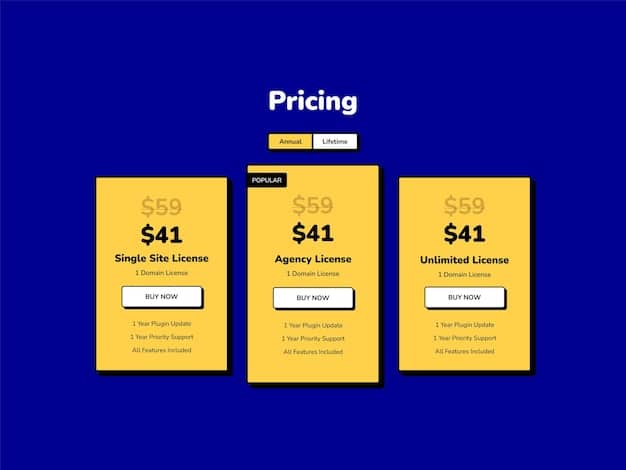E-commerce Platform Selection: Your US Business Needs in 3 Months

E-commerce platform selection is crucial for US businesses aiming to establish or improve their online presence within the next three months, requiring a careful assessment of various factors like scalability, cost, and integration capabilities.
Choosing the right ecommerce platform selection: choosing the right platform for your US business needs in the next 3 months is critical for any business looking to establish or enhance its online presence. This guide will help you navigate the complexities of selecting a platform that meets your specific needs and sets you up for success.
Understanding Your E-commerce Needs
Before diving into the specifics of various e-commerce platforms, it’s essential to understand your unique business requirements. This involves identifying key functionalities, defining your target audience, and projecting future growth.
Identifying Key Functionalities
Every business has different needs when it comes to e-commerce. Identifying these needs early can significantly streamline the selection process.
Defining Your Target Audience
Knowing your customers is vital. Understanding their preferences, behaviors, and demographics directly influences your platform choices.
- Consider the types of products you sell. Are they physical goods or digital products?
- Assess your technical skills. How comfortable are you with coding and website management?
- Think about your marketing strategy. Will you rely on SEO, social media, or email marketing?
- What payment methods do your customers prefer?
By aligning your platform choice with your audience’s needs, you can create a more engaging and effective online shopping experience.
Ultimately, understanding your e-commerce needs sets the foundation for making an informed platform selection, ensuring that the chosen solution supports your business goals and customer expectations. This careful planning will save time and resources in the long run.
Evaluating Different E-commerce Platforms
Once you have a clear understanding of your needs, the next step is to evaluate the various e-commerce platforms available. This includes comparing their features, pricing, scalability, and ease of use.

Shopify
Shopify is a popular, all-in-one e-commerce platform known for its ease of use and comprehensive feature set. It’s a great choice for businesses of all sizes, particularly those new to e-commerce.
WooCommerce
WooCommerce is a flexible, open-source e-commerce platform built on WordPress. It offers a high degree of customization, making it suitable for businesses with specific requirements.
- Shopify offers a user-friendly interface and robust marketing tools.
- WooCommerce provides extensive customization options and a large community support.
- BigCommerce is designed for larger businesses with complex needs.
- Assess your budget and consider long-term costs, including transaction fees and add-ons.
By carefully evaluating these platforms and considering your specific business needs, you can make an informed decision that sets you up for e-commerce success.
Analyzing Costs and Budget
Understanding the financial implications of different e-commerce platforms is crucial. It’s not just about the initial subscription fee but also considering transaction fees, add-ons, and potential development costs.
Subscription Fees
Most platforms offer tiered pricing plans with varying features. Evaluating the features needed against the pricing tiers helps in making a cost-effective decision.
Transaction Fees and Hidden Costs
Transaction fees can significantly impact your profit margins, especially for high-volume sales. Identifying and understanding these fees is crucial.

Ignoring these potential costs can lead to budget overruns and reduced profitability. Thorough planning and research are essential in managing your e-commerce budget.
Assessing Scalability and Growth Potential
Choosing an e-commerce platform isn’t just about meeting your current needs; it’s also about ensuring the platform can grow with your business. Scalability refers to the platform’s ability to handle increasing traffic, product listings, and transaction volumes without compromising performance.
Evaluating Scalability
Start by assessing the scalability options offered by each platform. Can the platform easily accommodate increasing product listings, traffic, and transactions?
Planning for Growth
Consider your long-term business plans. Are you planning to expand your product line? Will you be targeting new markets? Are you expecting a significant increase in sales volume?
- Look for platforms that offer integrations with other business tools, such as CRM, marketing automation, and accounting software.
- Consider platforms that offer flexible APIs, allowing you to customize the platform to meet your unique needs.
- Choose a platform with built-in analytics and reporting tools, making it easy to track your key metrics.
- Read online reviews and testimonials from other businesses in your industry to get an idea of the platform’s scalability and reliability.
By considering these factors, you can choose an e-commerce platform that not only meets your current needs but also positions your business for long-term growth and success.
Integration Capabilities and Compatibility
Successful e-commerce operations require seamless integration with various third-party tools and services. Evaluating the integration capabilities and compatibility of your chosen platform is essential for streamlining your workflows and enhancing the customer experience.
Third-Party Integrations
Identify the key third-party tools and services that you rely on for your business operations. This might include payment gateways, shipping providers, accounting software, email marketing platforms, and customer relationship management (CRM) systems.
API Availability
Does the platform offer a robust API (Application Programming Interface) that allows you to connect with other systems and build custom integrations?
Investing time in evaluating the integration capabilities of different e-commerce platforms can save you time, money, and frustration in the long run, enabling you to build a cohesive and efficient business ecosystem.
Testing and Implementation Strategies
Once you’ve selected your e-commerce platform, the next crucial step is to develop effective testing and implementation strategies. Testing ensures that your chosen platform functions as expected and integrates smoothly with your existing systems.
Testing Phase
Start with a thorough testing phase to identify and address any potential issues. This should include testing the platform’s core functionalities, such as product listings, shopping cart, checkout process, and payment processing.
Phased Implementation
Consider a phased implementation approach, where you gradually roll out the new platform to a subset of your customers before fully transitioning your entire business.
- Start with a small group of beta testers and gather feedback on their experience.
- Monitor key metrics to track the performance of the new platform.
- Prepare for unforeseen challenges and have a contingency plan in place.
- Invest in training and support for your team to ensure they are comfortable using the new platform.
By carefully planning and executing your testing and implementation strategies, you can minimize disruptions and ensure a smooth transition to your new e-commerce platform, ultimately setting your business up for long-term success.
| Key Aspect | Brief Description |
|---|---|
| 🎯 Identify Needs | Assess business requirements before platform selection. |
| ⚙️ Platform Evaluation | Compare features, pricing, and scalability of platforms like Shopify & WooCommerce. |
| 💰 Cost Analysis | Consider subscription, transaction, and potential hidden costs. |
| 📈 Scalability | Ensure the platform can handle increasing traffic and sales volume. |
Frequently Asked Questions
Key factors include your budget, the size and complexity of your product catalog, your technical expertise, and your long-term business goals. Additionally, consider the platform’s scalability, ease of use, and integration capabilities.
Check the platform’s integration capabilities and compatibility with your systems, such as payment gateways, shipping providers, and accounting software. Look for platforms with a robust API for custom integrations.
Costs typically include subscription fees, transaction fees, payment processing fees, marketing expenses, and potential development costs. Be sure to factor in costs for plugins, themes, and third-party integrations as well.
Conduct thorough testing of all functionalities, including product listings, shopping cart, checkout process, and payment processing. Use a beta testing group for realistic feedback before your official launch phase.
Scalability is very important, especially if you anticipate future growth. Ensure the platform can handle increasing traffic, product listings, and transaction volumes without compromising performance or customer experience.
Conclusion
Selecting the right e-commerce platform need a careful analysis of your business requirements, budget constraints, and growth objectives. By evaluating different platforms, considering integration capabilities, and testing thoroughly, you can make an informed decision that sets your US business up for success in the e-commerce landscape.





